Inclusive Play & Children's Rights in Early Childhood Education
VerifiedAdded on 2023/06/07
|6
|1281
|163
Report
AI Summary
This report examines the importance of play in early childhood education, focusing on how settings meet children's rights to play as outlined in the UN Convention on the Rights of the Child (UNCRC). It summarizes inclusive play practices in relation to current frameworks like the Charter for Children’s Play and the KIDS Inclusion Framework, emphasizing the need for accessible and non-discriminatory play environments. The analysis highlights how play supports children's interests and abilities, referencing theories such as Montessori's and Vygotsky's, which underscore the role of play in cognitive and social development. The report concludes that play is essential for meeting the developmental needs and rights of children in early years settings.
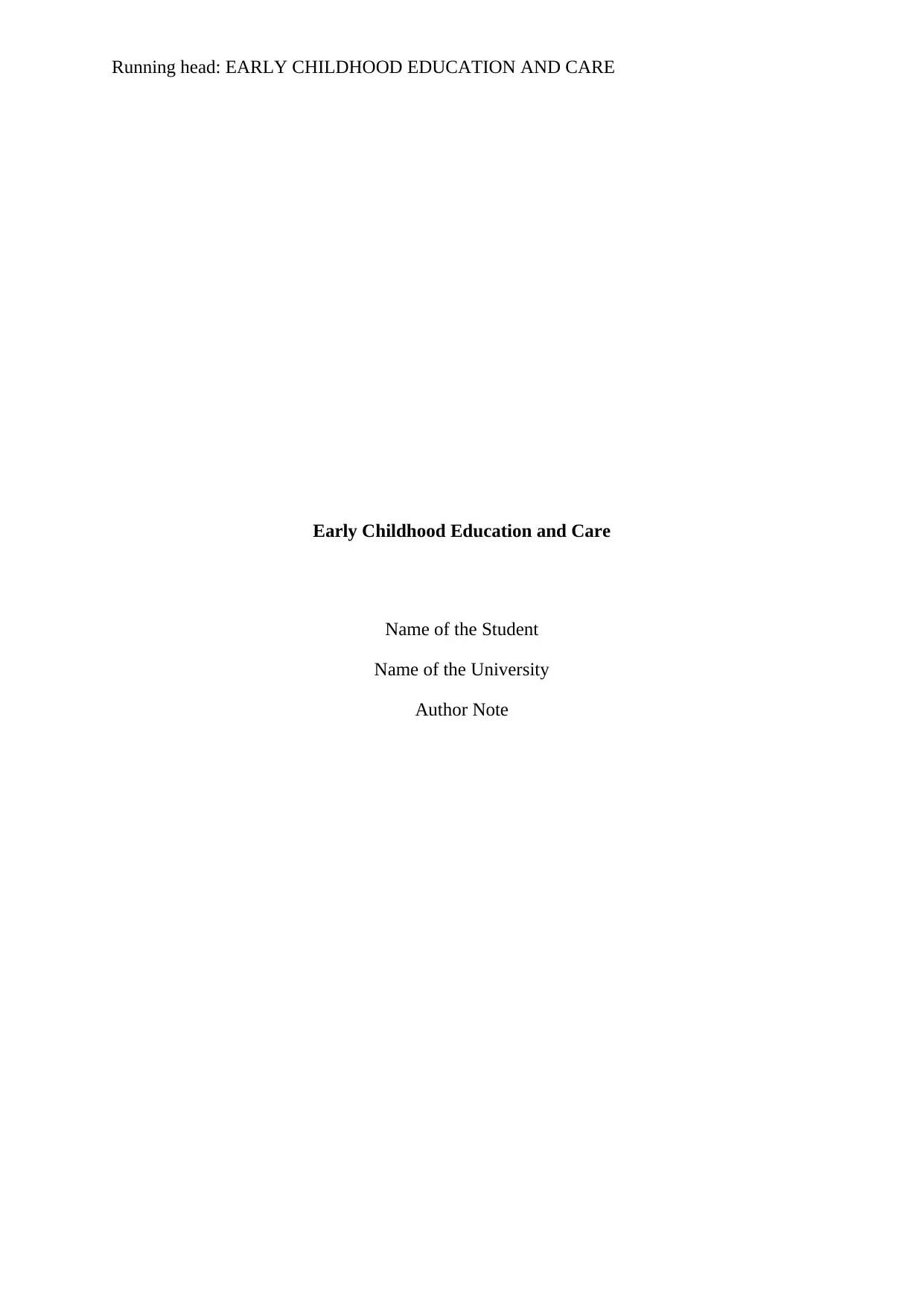
Running head: EARLY CHILDHOOD EDUCATION AND CARE
Early Childhood Education and Care
Name of the Student
Name of the University
Author Note
Early Childhood Education and Care
Name of the Student
Name of the University
Author Note
Paraphrase This Document
Need a fresh take? Get an instant paraphrase of this document with our AI Paraphraser
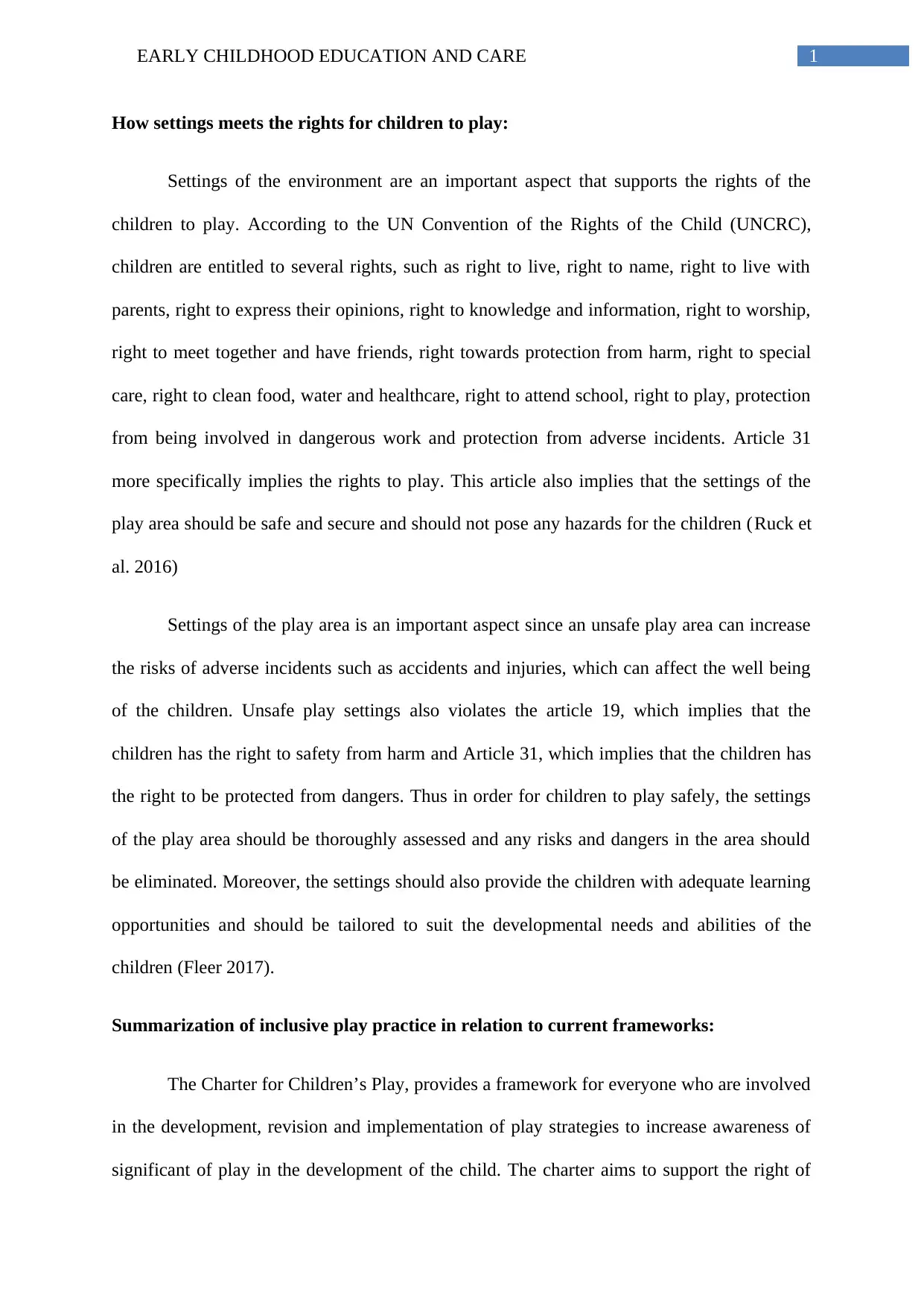
1EARLY CHILDHOOD EDUCATION AND CARE
How settings meets the rights for children to play:
Settings of the environment are an important aspect that supports the rights of the
children to play. According to the UN Convention of the Rights of the Child (UNCRC),
children are entitled to several rights, such as right to live, right to name, right to live with
parents, right to express their opinions, right to knowledge and information, right to worship,
right to meet together and have friends, right towards protection from harm, right to special
care, right to clean food, water and healthcare, right to attend school, right to play, protection
from being involved in dangerous work and protection from adverse incidents. Article 31
more specifically implies the rights to play. This article also implies that the settings of the
play area should be safe and secure and should not pose any hazards for the children (Ruck et
al. 2016)
Settings of the play area is an important aspect since an unsafe play area can increase
the risks of adverse incidents such as accidents and injuries, which can affect the well being
of the children. Unsafe play settings also violates the article 19, which implies that the
children has the right to safety from harm and Article 31, which implies that the children has
the right to be protected from dangers. Thus in order for children to play safely, the settings
of the play area should be thoroughly assessed and any risks and dangers in the area should
be eliminated. Moreover, the settings should also provide the children with adequate learning
opportunities and should be tailored to suit the developmental needs and abilities of the
children (Fleer 2017).
Summarization of inclusive play practice in relation to current frameworks:
The Charter for Children’s Play, provides a framework for everyone who are involved
in the development, revision and implementation of play strategies to increase awareness of
significant of play in the development of the child. The charter aims to support the right of
How settings meets the rights for children to play:
Settings of the environment are an important aspect that supports the rights of the
children to play. According to the UN Convention of the Rights of the Child (UNCRC),
children are entitled to several rights, such as right to live, right to name, right to live with
parents, right to express their opinions, right to knowledge and information, right to worship,
right to meet together and have friends, right towards protection from harm, right to special
care, right to clean food, water and healthcare, right to attend school, right to play, protection
from being involved in dangerous work and protection from adverse incidents. Article 31
more specifically implies the rights to play. This article also implies that the settings of the
play area should be safe and secure and should not pose any hazards for the children (Ruck et
al. 2016)
Settings of the play area is an important aspect since an unsafe play area can increase
the risks of adverse incidents such as accidents and injuries, which can affect the well being
of the children. Unsafe play settings also violates the article 19, which implies that the
children has the right to safety from harm and Article 31, which implies that the children has
the right to be protected from dangers. Thus in order for children to play safely, the settings
of the play area should be thoroughly assessed and any risks and dangers in the area should
be eliminated. Moreover, the settings should also provide the children with adequate learning
opportunities and should be tailored to suit the developmental needs and abilities of the
children (Fleer 2017).
Summarization of inclusive play practice in relation to current frameworks:
The Charter for Children’s Play, provides a framework for everyone who are involved
in the development, revision and implementation of play strategies to increase awareness of
significant of play in the development of the child. The charter aims to support the right of
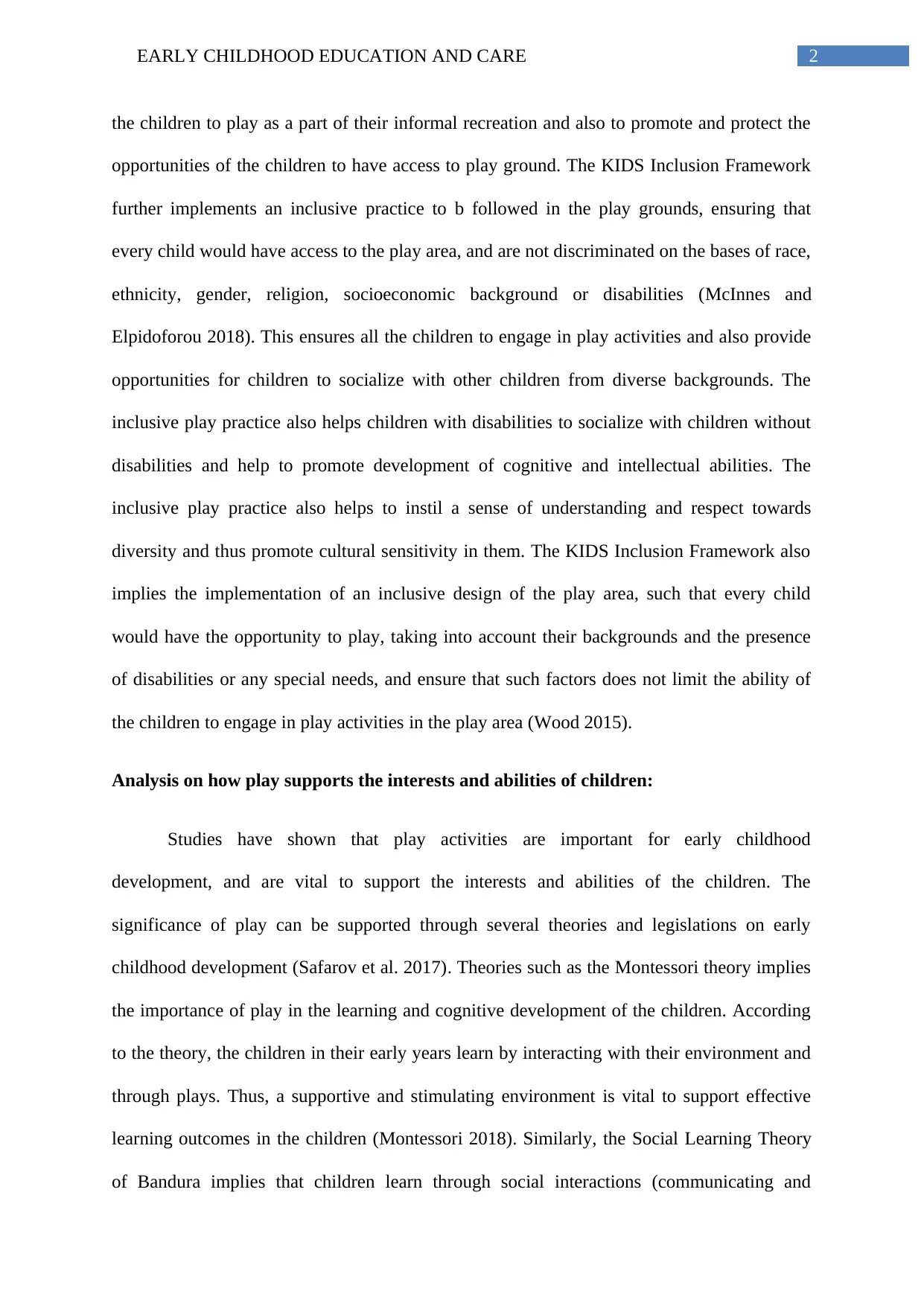
2EARLY CHILDHOOD EDUCATION AND CARE
the children to play as a part of their informal recreation and also to promote and protect the
opportunities of the children to have access to play ground. The KIDS Inclusion Framework
further implements an inclusive practice to b followed in the play grounds, ensuring that
every child would have access to the play area, and are not discriminated on the bases of race,
ethnicity, gender, religion, socioeconomic background or disabilities (McInnes and
Elpidoforou 2018). This ensures all the children to engage in play activities and also provide
opportunities for children to socialize with other children from diverse backgrounds. The
inclusive play practice also helps children with disabilities to socialize with children without
disabilities and help to promote development of cognitive and intellectual abilities. The
inclusive play practice also helps to instil a sense of understanding and respect towards
diversity and thus promote cultural sensitivity in them. The KIDS Inclusion Framework also
implies the implementation of an inclusive design of the play area, such that every child
would have the opportunity to play, taking into account their backgrounds and the presence
of disabilities or any special needs, and ensure that such factors does not limit the ability of
the children to engage in play activities in the play area (Wood 2015).
Analysis on how play supports the interests and abilities of children:
Studies have shown that play activities are important for early childhood
development, and are vital to support the interests and abilities of the children. The
significance of play can be supported through several theories and legislations on early
childhood development (Safarov et al. 2017). Theories such as the Montessori theory implies
the importance of play in the learning and cognitive development of the children. According
to the theory, the children in their early years learn by interacting with their environment and
through plays. Thus, a supportive and stimulating environment is vital to support effective
learning outcomes in the children (Montessori 2018). Similarly, the Social Learning Theory
of Bandura implies that children learn through social interactions (communicating and
the children to play as a part of their informal recreation and also to promote and protect the
opportunities of the children to have access to play ground. The KIDS Inclusion Framework
further implements an inclusive practice to b followed in the play grounds, ensuring that
every child would have access to the play area, and are not discriminated on the bases of race,
ethnicity, gender, religion, socioeconomic background or disabilities (McInnes and
Elpidoforou 2018). This ensures all the children to engage in play activities and also provide
opportunities for children to socialize with other children from diverse backgrounds. The
inclusive play practice also helps children with disabilities to socialize with children without
disabilities and help to promote development of cognitive and intellectual abilities. The
inclusive play practice also helps to instil a sense of understanding and respect towards
diversity and thus promote cultural sensitivity in them. The KIDS Inclusion Framework also
implies the implementation of an inclusive design of the play area, such that every child
would have the opportunity to play, taking into account their backgrounds and the presence
of disabilities or any special needs, and ensure that such factors does not limit the ability of
the children to engage in play activities in the play area (Wood 2015).
Analysis on how play supports the interests and abilities of children:
Studies have shown that play activities are important for early childhood
development, and are vital to support the interests and abilities of the children. The
significance of play can be supported through several theories and legislations on early
childhood development (Safarov et al. 2017). Theories such as the Montessori theory implies
the importance of play in the learning and cognitive development of the children. According
to the theory, the children in their early years learn by interacting with their environment and
through plays. Thus, a supportive and stimulating environment is vital to support effective
learning outcomes in the children (Montessori 2018). Similarly, the Social Learning Theory
of Bandura implies that children learn through social interactions (communicating and
⊘ This is a preview!⊘
Do you want full access?
Subscribe today to unlock all pages.

Trusted by 1+ million students worldwide
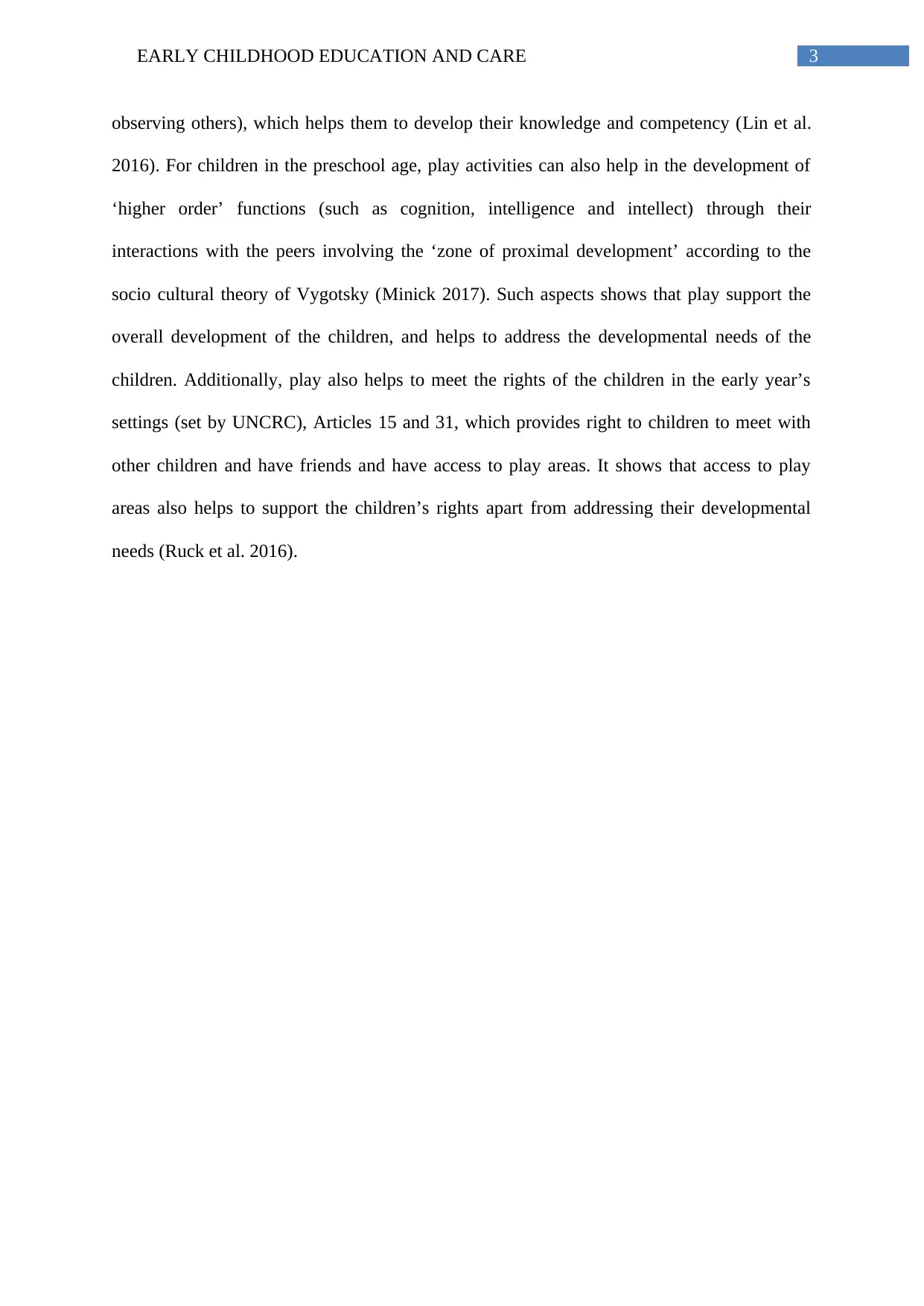
3EARLY CHILDHOOD EDUCATION AND CARE
observing others), which helps them to develop their knowledge and competency (Lin et al.
2016). For children in the preschool age, play activities can also help in the development of
‘higher order’ functions (such as cognition, intelligence and intellect) through their
interactions with the peers involving the ‘zone of proximal development’ according to the
socio cultural theory of Vygotsky (Minick 2017). Such aspects shows that play support the
overall development of the children, and helps to address the developmental needs of the
children. Additionally, play also helps to meet the rights of the children in the early year’s
settings (set by UNCRC), Articles 15 and 31, which provides right to children to meet with
other children and have friends and have access to play areas. It shows that access to play
areas also helps to support the children’s rights apart from addressing their developmental
needs (Ruck et al. 2016).
observing others), which helps them to develop their knowledge and competency (Lin et al.
2016). For children in the preschool age, play activities can also help in the development of
‘higher order’ functions (such as cognition, intelligence and intellect) through their
interactions with the peers involving the ‘zone of proximal development’ according to the
socio cultural theory of Vygotsky (Minick 2017). Such aspects shows that play support the
overall development of the children, and helps to address the developmental needs of the
children. Additionally, play also helps to meet the rights of the children in the early year’s
settings (set by UNCRC), Articles 15 and 31, which provides right to children to meet with
other children and have friends and have access to play areas. It shows that access to play
areas also helps to support the children’s rights apart from addressing their developmental
needs (Ruck et al. 2016).
Paraphrase This Document
Need a fresh take? Get an instant paraphrase of this document with our AI Paraphraser
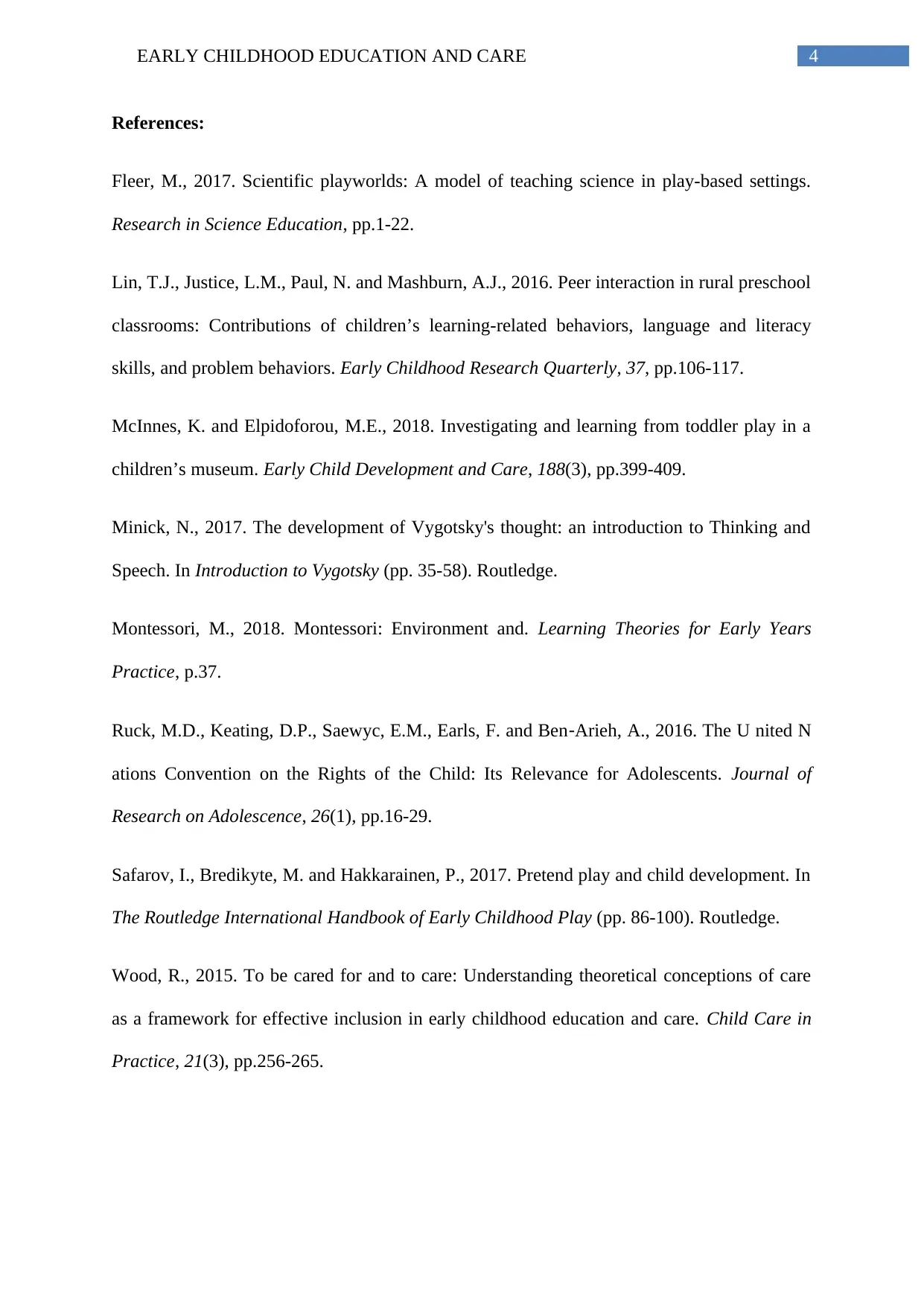
4EARLY CHILDHOOD EDUCATION AND CARE
References:
Fleer, M., 2017. Scientific playworlds: A model of teaching science in play-based settings.
Research in Science Education, pp.1-22.
Lin, T.J., Justice, L.M., Paul, N. and Mashburn, A.J., 2016. Peer interaction in rural preschool
classrooms: Contributions of children’s learning-related behaviors, language and literacy
skills, and problem behaviors. Early Childhood Research Quarterly, 37, pp.106-117.
McInnes, K. and Elpidoforou, M.E., 2018. Investigating and learning from toddler play in a
children’s museum. Early Child Development and Care, 188(3), pp.399-409.
Minick, N., 2017. The development of Vygotsky's thought: an introduction to Thinking and
Speech. In Introduction to Vygotsky (pp. 35-58). Routledge.
Montessori, M., 2018. Montessori: Environment and. Learning Theories for Early Years
Practice, p.37.
Ruck, M.D., Keating, D.P., Saewyc, E.M., Earls, F. and Ben‐Arieh, A., 2016. The U nited N
ations Convention on the Rights of the Child: Its Relevance for Adolescents. Journal of
Research on Adolescence, 26(1), pp.16-29.
Safarov, I., Bredikyte, M. and Hakkarainen, P., 2017. Pretend play and child development. In
The Routledge International Handbook of Early Childhood Play (pp. 86-100). Routledge.
Wood, R., 2015. To be cared for and to care: Understanding theoretical conceptions of care
as a framework for effective inclusion in early childhood education and care. Child Care in
Practice, 21(3), pp.256-265.
References:
Fleer, M., 2017. Scientific playworlds: A model of teaching science in play-based settings.
Research in Science Education, pp.1-22.
Lin, T.J., Justice, L.M., Paul, N. and Mashburn, A.J., 2016. Peer interaction in rural preschool
classrooms: Contributions of children’s learning-related behaviors, language and literacy
skills, and problem behaviors. Early Childhood Research Quarterly, 37, pp.106-117.
McInnes, K. and Elpidoforou, M.E., 2018. Investigating and learning from toddler play in a
children’s museum. Early Child Development and Care, 188(3), pp.399-409.
Minick, N., 2017. The development of Vygotsky's thought: an introduction to Thinking and
Speech. In Introduction to Vygotsky (pp. 35-58). Routledge.
Montessori, M., 2018. Montessori: Environment and. Learning Theories for Early Years
Practice, p.37.
Ruck, M.D., Keating, D.P., Saewyc, E.M., Earls, F. and Ben‐Arieh, A., 2016. The U nited N
ations Convention on the Rights of the Child: Its Relevance for Adolescents. Journal of
Research on Adolescence, 26(1), pp.16-29.
Safarov, I., Bredikyte, M. and Hakkarainen, P., 2017. Pretend play and child development. In
The Routledge International Handbook of Early Childhood Play (pp. 86-100). Routledge.
Wood, R., 2015. To be cared for and to care: Understanding theoretical conceptions of care
as a framework for effective inclusion in early childhood education and care. Child Care in
Practice, 21(3), pp.256-265.

5EARLY CHILDHOOD EDUCATION AND CARE
⊘ This is a preview!⊘
Do you want full access?
Subscribe today to unlock all pages.

Trusted by 1+ million students worldwide
1 out of 6
Related Documents
Your All-in-One AI-Powered Toolkit for Academic Success.
+13062052269
info@desklib.com
Available 24*7 on WhatsApp / Email
![[object Object]](/_next/static/media/star-bottom.7253800d.svg)
Unlock your academic potential
Copyright © 2020–2025 A2Z Services. All Rights Reserved. Developed and managed by ZUCOL.




